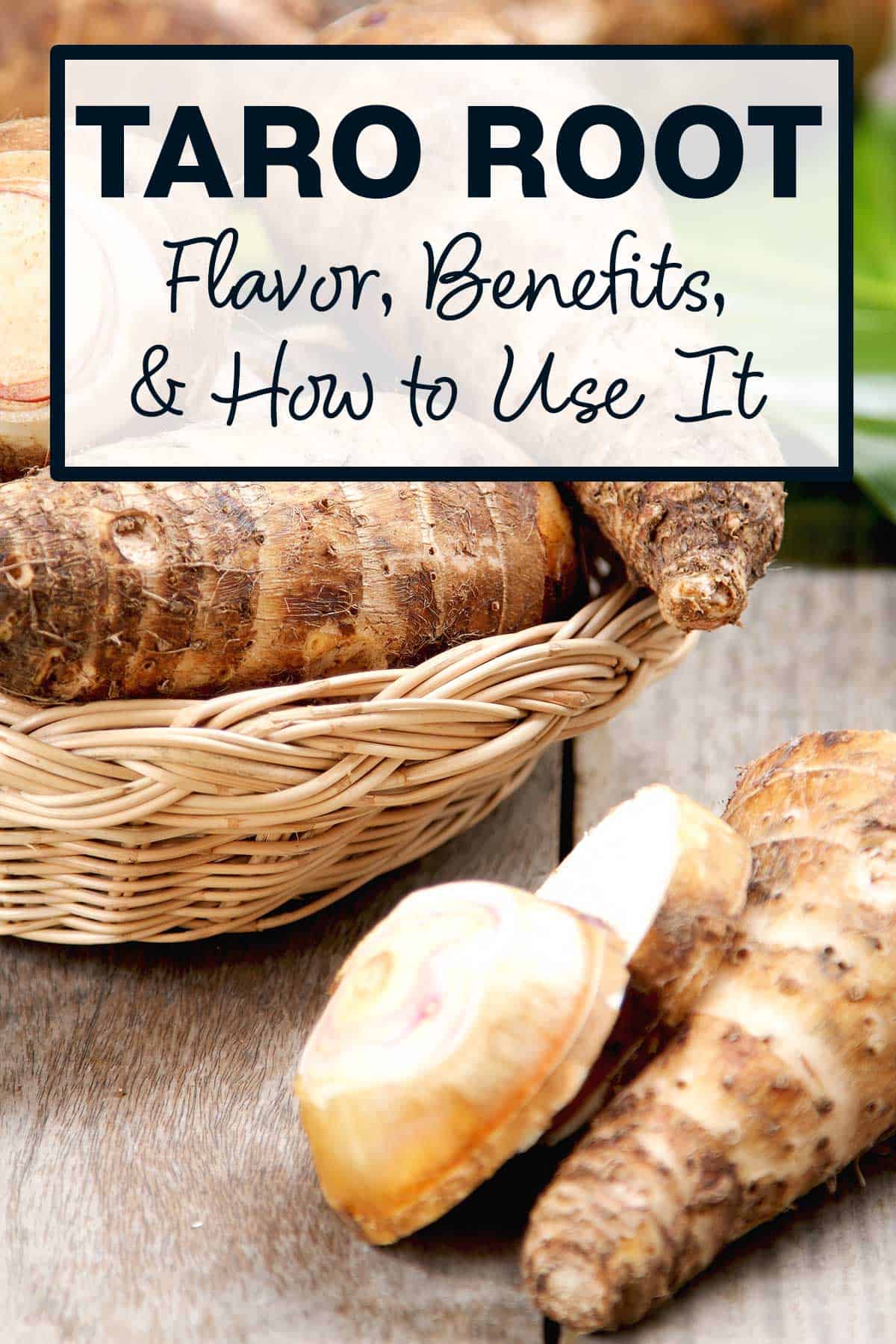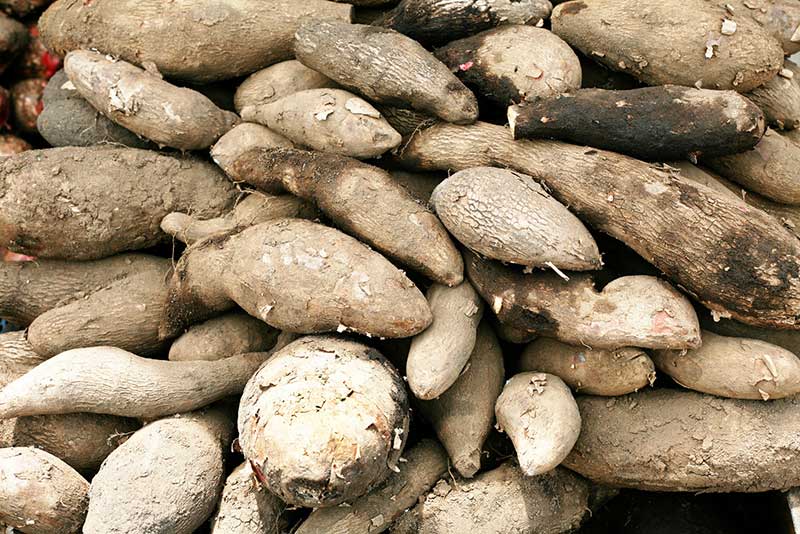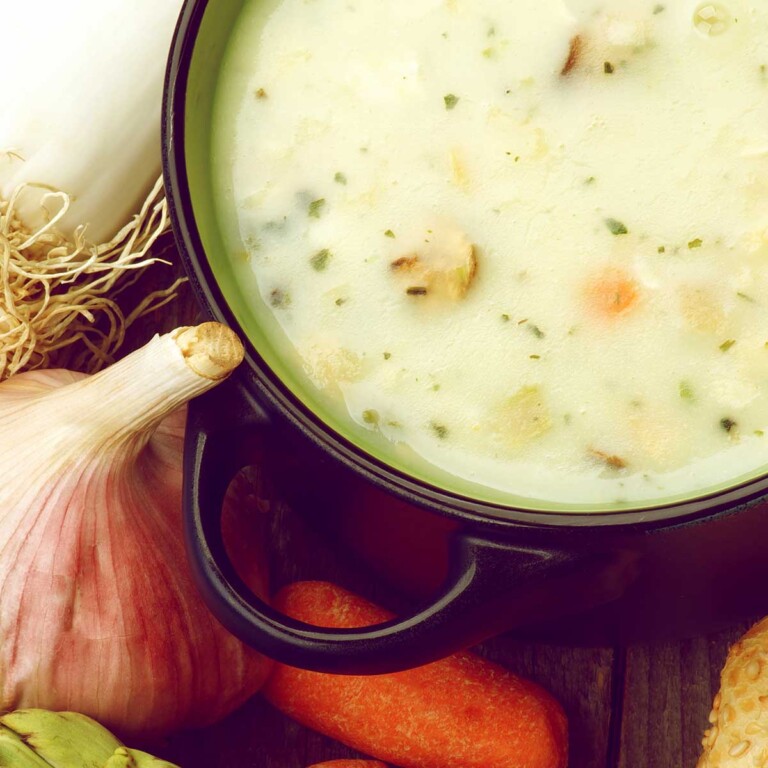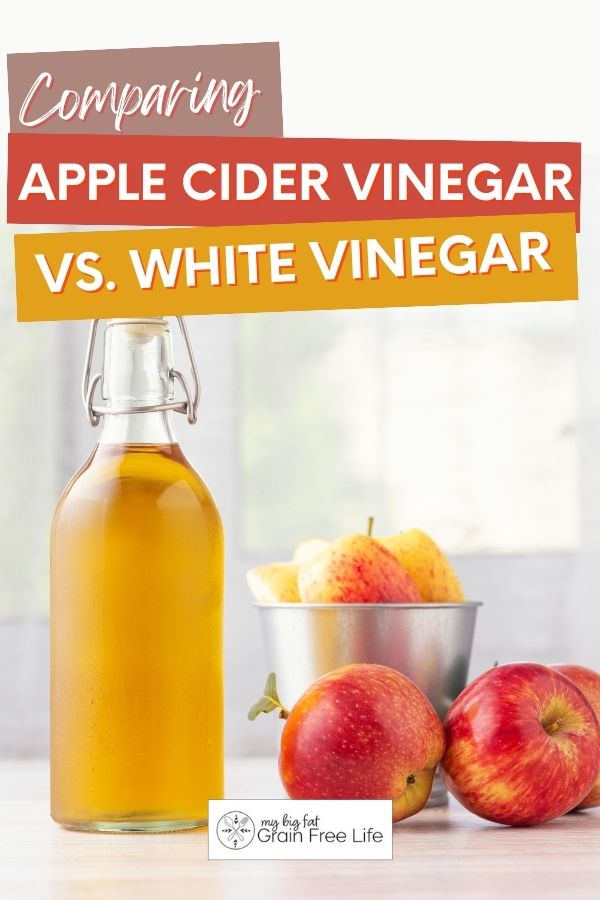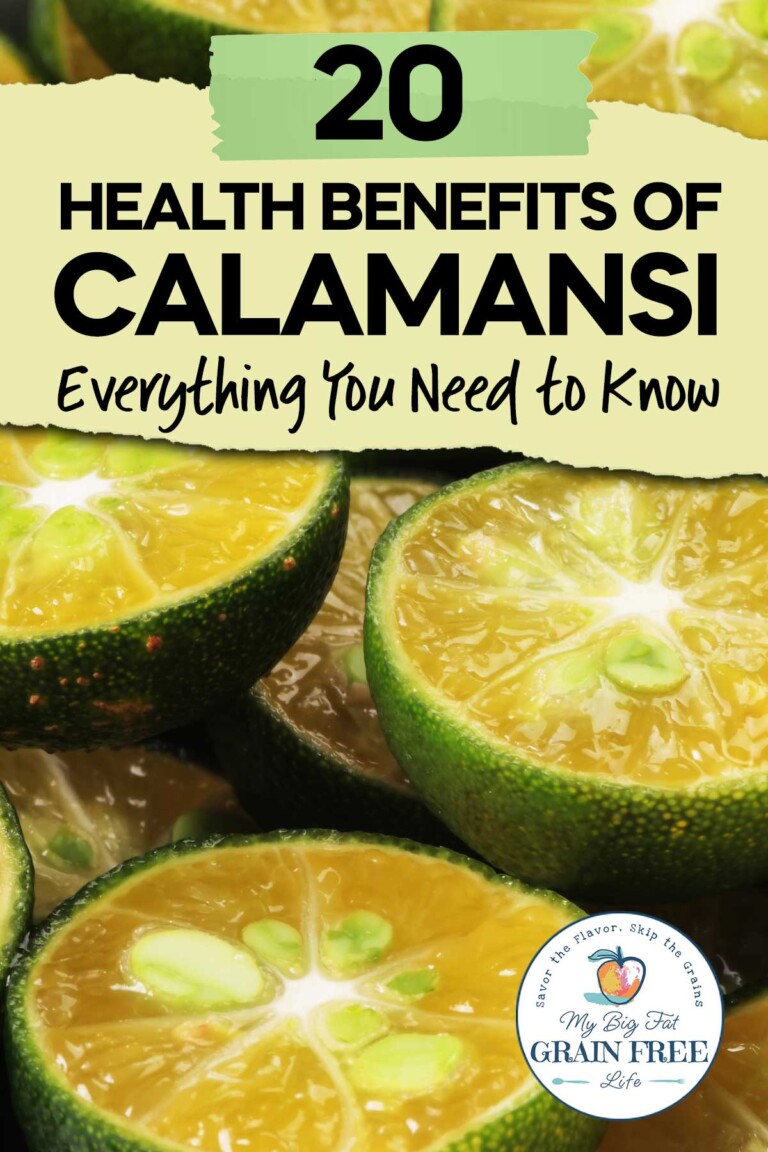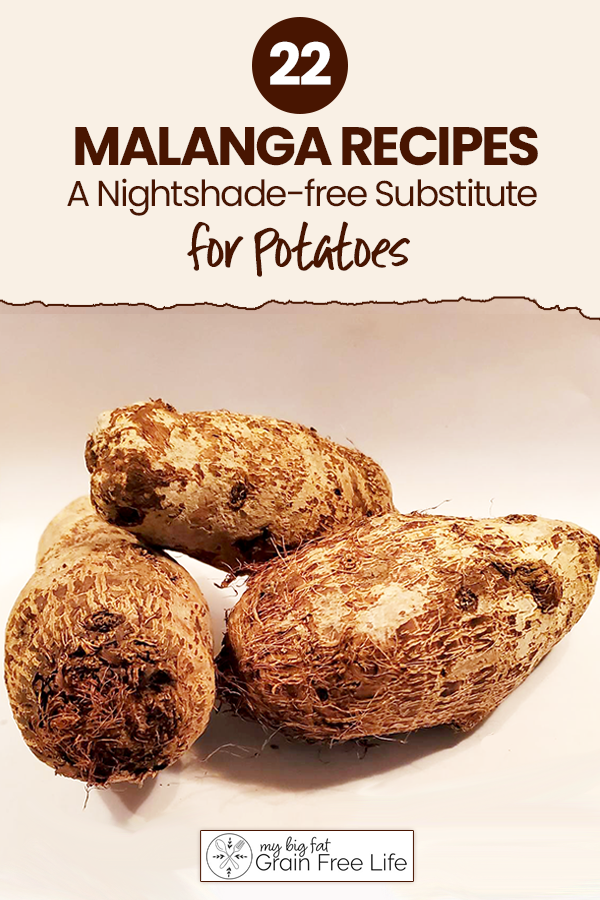What are Tubers? 50 Tuber Crops with Uses and Nutrition
This post may contain affiliate links. If you make purchase after clicking a link, I may receive a commission at no extra cost to you.
Last Updated on September 17, 2023
Tubers are an essential part of a healthy lifestyle, offering a wide range of nutrients and flavors. From the common potato tubers to the exotic root tubers found in South America, these tuber vegetables have been cherished as staple foods for centuries.
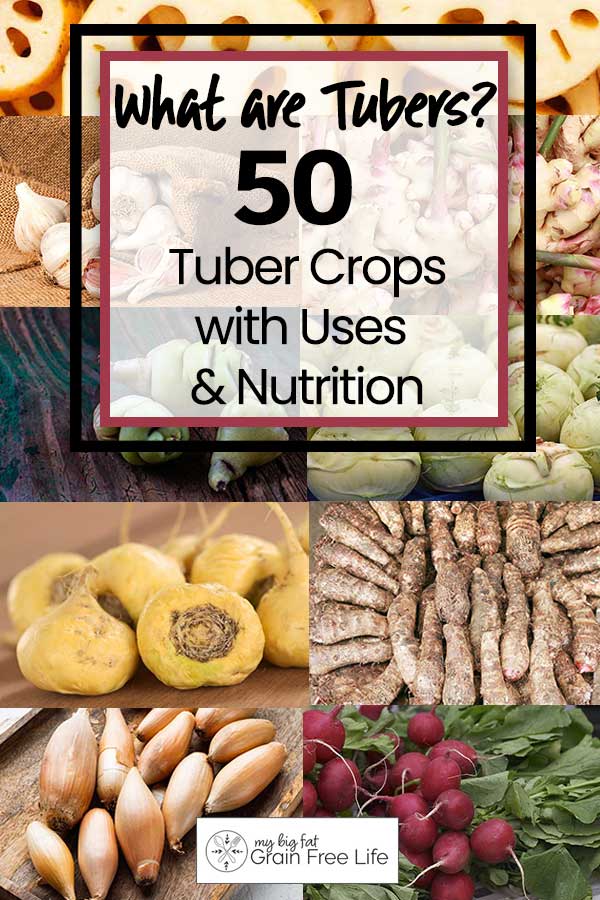
Tubers
A tuber is a type of plant stem that stores nutrients and energy for the plant. It is usually found underground and serves as a food source for both the plant and humans.
Tubers are rich in carbohydrates, fiber, vitamins, and minerals, making them a nutritious addition to a healthy diet. They can be cooked in various ways, such as boiling, baking, or frying, and can be used in numerous recipes to add flavor and texture to meals.
Tuber Vegetables
Root veggies and tubers are important additions to a healthy diet. Tubers are a type of root vegetable that boast a lot of nutritional benefits.
Tuber vegetables encompass various groups, including root tubers, true tubers, and storage roots. These underground structures, derived from the parent plant’s stem or root, serve as energy reservoirs for the growth of new plant shoots.
They come in different shapes, sizes, and colors – from small tubers like new potatoes to a large tuber found in some potato varieties.
What Makes a Tuber a Tuber?
A tuber is a root vegetable that produces several “children” per plant, unlike a root vegetable that only produces one vegetable per plant. Some tubers are also cruciferous vegetables, such as radishes, kholrabi, and more.
How Tubers Grow
Tubers are a fascinating component of the plant kingdom, serving as a vital storage organ for new plants. Among the most well-known tuber crops is the potato plant, which produces starchy roots commonly known as potatoes.
These large tubers play a crucial role in the growth and propagation of the potato plant.
New tubers are formed by the potato plant as a means of reproduction and survival. Within the plant, there are different groups of tubers, each with its own unique characteristics.
Tuber formation can vary depending on various factors such as the variety of potatoes and environmental conditions. The number of tubers produced will vary based on these conditions.
The Nutritional Value of Edible Tubers
Tuber vegetables are renowned for their high nutritional content. They serve as an excellent source of carbohydrates, dietary fiber, and essential minerals.
Potatoes, for instance, provide a significant amount of vitamin C and potassium, while celery root offers dietary fiber and vitamin K. Incorporating tubers into your diet can contribute to improved digestion, boosted immunity, and overall well-being.
What’s the Difference Between Root Vegetables and Tubers?
When it comes to the world of vegetables, terms like root vegetables and tubers are often used interchangeably, leading to confusion. All tubers are root vegetables, but not all root vegetables are tubers.
- Root vegetables are uniquely named due to the fact that the most valuable part of these crops lies beneath the surface – their roots. These roots grow downwards, drawing in essential moisture and nutrients from the soil. While the above ground structure of the plant provides greenery, it is the root that truly holds the nutritional treasure underground.
- Tubers, the thickened part of an underground stem of a plant, serve as energy storage and provide support for new stem growth. Unlike root crops, tubers are characterized by a system of hairy-like roots beneath the surface. This intricate system allows for the growth of multiple tubers from a single above-ground plant, whereas root crops produce one root vegetable per plant.
The bottom line: You can harvest multiple tubers from a single above-ground plant, while root crops yield a single vegetable per plant.
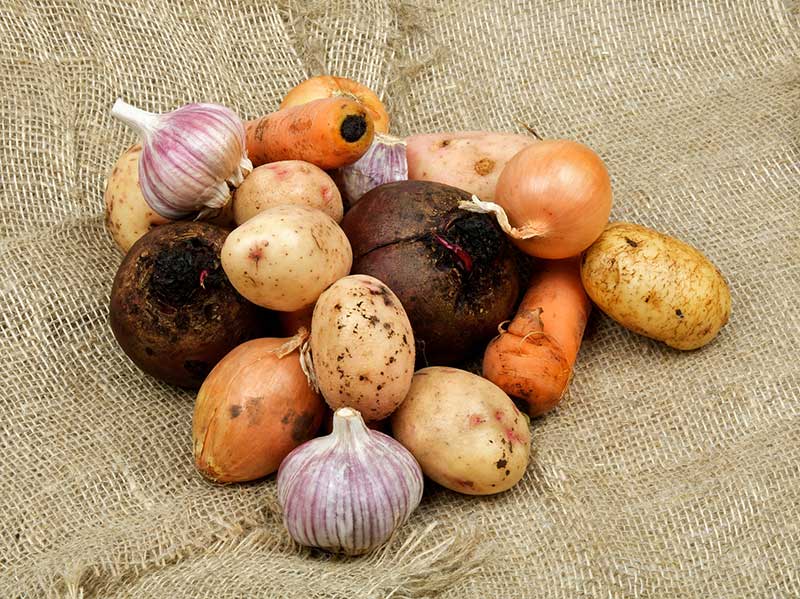
Types of Tubers
Tuber vegetables can be categorized into numerous groups, each with its unique characteristics. Some common tubers include potatoes, sweet potatoes, yams, and cassava. Additionally, lesser-known tubers like jicama and taro root offer intriguing flavors and culinary possibilities.
Stem Tubers
Stem tubers are swollen structures that develop from the stem of certain plants. Examples include potatoes and yams. These tubers store nutrients and water for the plant, helping it survive during unfavorable conditions.
Rhizomes
Rhizomes are underground stem structures that grow horizontally. They are characterized by nodes and internodes. Common examples include ginger and turmeric. Rhizomes serve as storage organs and can produce new shoots and roots.
Tuberous Roots
Tuberous roots are thickened roots that store nutrients for plants. They do not have nodes or internodes like rhizomes. Examples of tuberous roots include sweet potatoes and cassava.
Tuberous roots are an excellent source of carbohydrates and other essential nutrients.
Corms
Corms are swollen, underground stem bases that serve as storage organs. Taro is a great example of a corm.
They are solid structures and do not possess nodes or internodes. Plants like taro and gladiolus grow from corms. Corms are rich in starch and provide energy for the plant and humans alike.
Bulbs
Bulbs consist of layers of fleshy leaves, called scales, that surround an underground stem. Onions and garlic are prime examples of bulbs. These tubers have a pungent taste and are used as flavoring agents in various cuisines.
Tubercles
Tubercles are small, irregularly shaped tubers that form on the roots or stems of certain plants. Examples include Jerusalem artichokes and Chinese yam. Tubercles are rich in dietary fiber and can be cooked in various ways.
Tuber vegetables come in all shapes, sizes, different colors, and often go by different names.
They contain important nutrients are are mainly available year round. The most popular root vegetable that’s a tuber is the potato.
List of Tubers
Tubers, including the versatile and well-loved potato, are remarkable storage organs that help new plants thrive. With their different groups, varying numbers, and diverse varieties, tubers provide a rich source of nourishment and flavor.
Let’s explore the captivating world of tuber vegetables, their culinary diversity, and their significance as a form of starch-rich sustenance.
We’ll take a look at 50 different examples of tuber vegetables and explain how you can enjoy these starchy veggies and edible roots.

1. Potato
Potatoes are starchy tubers with a smooth texture perfect for frying, baking, or mashing. They are part of the nightshade family of foods.
From the red-skinned russets to the yellow-fleshed Yukon golds, the world of potatoes offers an array of flavors, textures, and colors. These varieties of potatoes are categorized into various types, including russet, fingerling, and red, each possessing its distinct qualities.
The edible root of the potato plant is, in fact, a stem tuber. Unlike root vegetables such as carrots or beets, which have an edible root that grows directly from the taproot, the potato’s edible root is formed from the thick underground stems called stolons.
These stem tubers develop as a result of special growth processes within the plant.
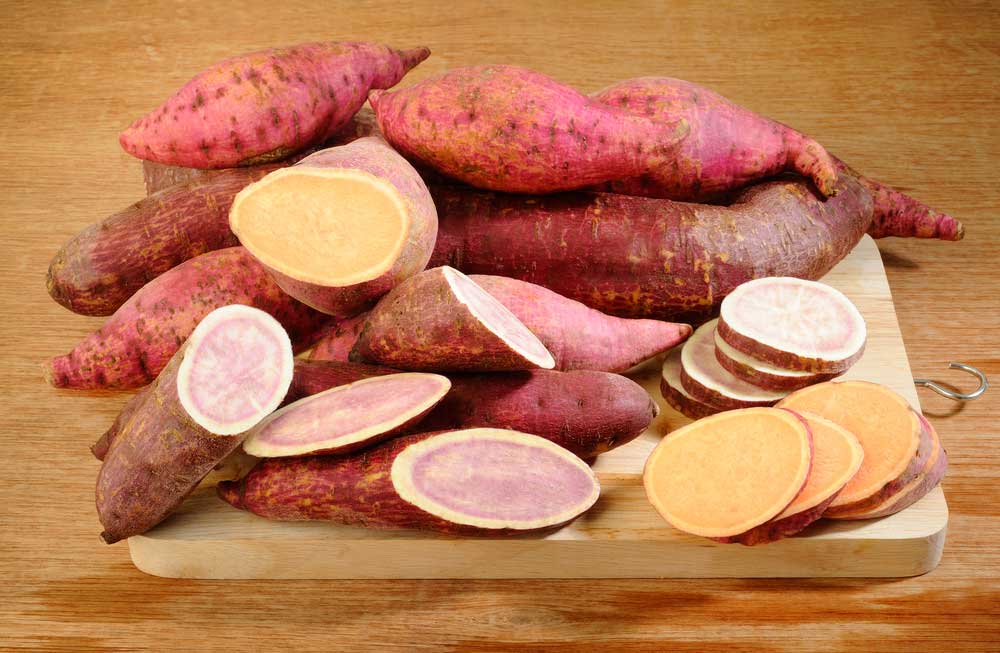
2. Sweet Potato
Sweet potatoes, including orange, purple, and white sweet potatoes, are a versatile and nutritious tuber with a naturally sweet taste and a creamy texture. This delicious root vegetable not only satisfies the taste buds, but they’re also super nutritious!
Rich in dietary fiber, potassium, and vitamin A, sweet potatoes can support healthy digestion, regulate blood pressure, and promote good vision.
Whether baked, roasted, or mashed, these delicious tubers are a nutrient-dense choice for those looking to incorporate wholesome foods into their diet.
Check out these delicious white sweet potato recipes to get some inspiration for new meal ideas.

3. Yam
Often confused with sweet potatoes, yams have a starchy texture and a slightly sweet flavor, commonly used in African and Caribbean cuisine. Not only are they delicious, but they also full of vitamins and nutrients.
Rich in vitamins A and C, yams are excellent for boosting immune function and promoting healthy skin. These root vegetables are also high in fiber, aiding in digestion and promoting a feeling of fullness.
Additionally, yams provide a good source of potassium, which is vital for maintaining proper heart function.
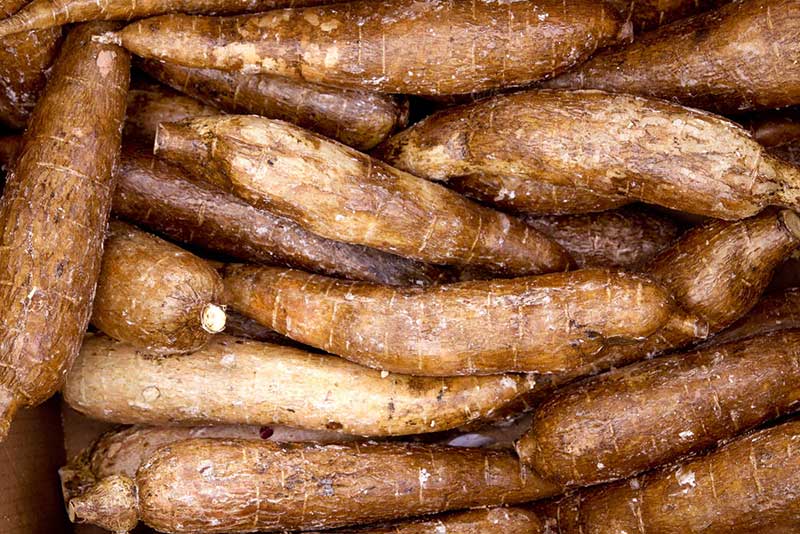
4. Cassava
These starchy root vegetables have a very mild taste. It’s a staple in many diets, particularly in Africa, Asia, and South America. Used both as a flour and consumed as a whole, it serves as a vital ingredient in various regional dishes.
This nutrient-packed tuber is a rich source of carbohydrates, providing sustained energy while also being naturally gluten-free, making it an excellent alternative for individuals with gluten sensitivities or celiac disease.
Additionally, cassava is a great source of vitamin C and contains important vitamins and minerals such as folate, and potassium. Whether boiled, fried, or baked, cassava offers a delicious and nutritious addition to any meal.
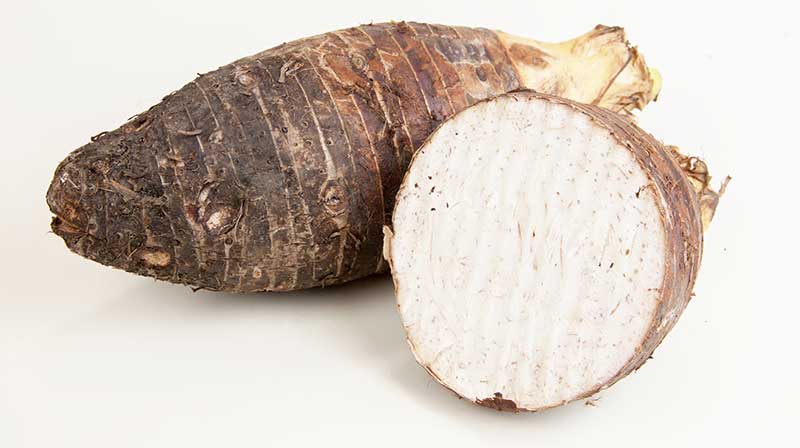
5. Taro
This nutrient-dense root vegetable is a great source of dietary fiber, vitamins, and minerals, including potassium, vitamin E, and magnesium.
Beyond its nutritional value, taro offers a wide array of culinary uses. From being boiled, steamed, or roasted to make tasty side dishes or stews, to being transformed into crispy taro chips or taro desserts, this tuber adds a unique and satisfying touch to any dish.
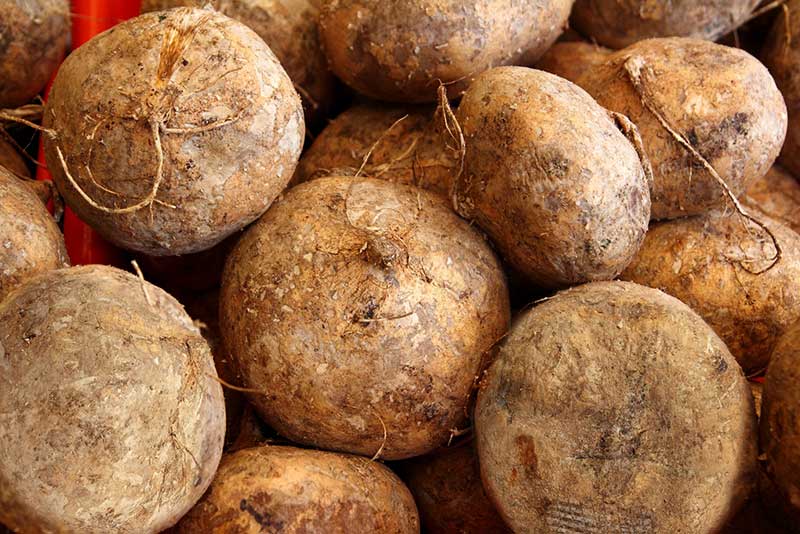
6. Jicama
Crisp and refreshing, jicama is a tuberous, low-starch root vegetable that can be enjoyed raw, sliced into sticks for a crunchy snack, or incorporated into salads, slaws, and stir-fries.
Loaded with fiber, vitamin C, and essential minerals like potassium and manganese, jicama promotes digestive health, boosts the immune system, and supports overall well-being. Its low-calorie content also makes it an excellent choice for weight management.
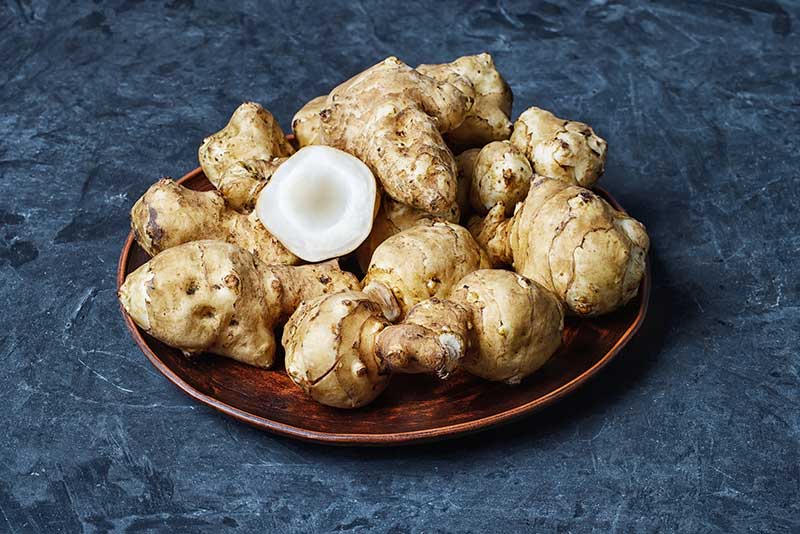
7. Jerusalem Artichoke
Despite its name, it is not actually an artichoke, but rather a type of tuber. The taste of Jerusalem artichoke can be described as nutty, sweet, and slightly earthy, making it a unique and flavorful choice for various dishes.
Nutritionally, it is full of essential vitamins, minerals, and dietary fiber. It is particularly rich in potassium, iron, and vitamin C, making it a great choice for immune support and maintaining healthy blood pressure levels.
Its unique composition of carbohydrates also makes it a favorable option for those watching their blood sugar levels.
Recommended: Jerusalem Artichoke vs Artichoke

8. Ñame
Pronounced as ‘nyah-me’, this tuber boasts a unique blend of sweet and nutty flavors, making it a delightful addition to various dishes. Its creamy texture adds a satisfying element to both savory and sweet recipes, making it a versatile ingredient in the kitchen.
Ñame can be boiled, baked, roasted, or mashed to create a multitude of delicious dishes. It can be used as a nutritious substitute for potatoes in stews, soups, and casseroles, providing a hearty and wholesome addition to your meals.
Additionally, Ñame also shines in desserts, adding a natural sweetness and rich flavor to cakes, pies, and puddings.
Apart from its taste and versatility, Ñame boasts an impressive nutritional profile. Loaded with dietary fiber, vitamins, and minerals, it is a healthy choice for those seeking a balanced diet. Ñame is particularly rich in vitamin C, potassium, and manganese.
9. Arrowroot
Derived from the rhizomes of a tropical plant, arrowroot is a gluten-free starch used as a thickening agent in cooking and baking. With its high content of potassium, iron, and B vitamins, arrowroot provides a valuable source of nutrients for those seeking a well-balanced diet.

10. Ginger
This knobby root, often used as a spice in culinary dishes and a herbal remedy in traditional medicine, offers a delightful taste that is both spicy and slightly sweet.
Beyond its culinary applications, ginger boasts an impressive nutritional profile, packed with essential vitamins and minerals, including vitamin C, potassium, and manganese.
Known for its anti-inflammatory and antioxidant properties, ginger has been used for centuries to aid digestion, alleviate nausea, and reduce muscle soreness.
Have acid reflux? Ginger tea is great for acid reflux.

11. Turmeric
Renowned for its distinct flavor profile and therapeutic properties, turmeric offers a unique earthy and slightly bitter taste, enhancing dishes with an aromatic and warm essence.
Beyond its culinary appeal, turmeric is highly regarded for its potential health benefits.
This ancient spice is rich in curcumin, a compound recognized for its anti-inflammatory and antioxidant properties. Moreover, turmeric is a good source of dietary fiber, vitamins, and minerals, including manganese and iron.

12. Horseradish
This pungent root vegetable delivers a spicy and tangy taste to dishes. With its strong aroma and sharp taste, horseradish is often used as a condiment, adding a zing to sauces, dressings, and marinades.
However, it offers more than just a flavorful kick – horseradish is also full of nutrients. Rich in antioxidants, vitamin C, and minerals like calcium and potassium, horseradish boosts the immune system, promotes digestion, and supports overall health.
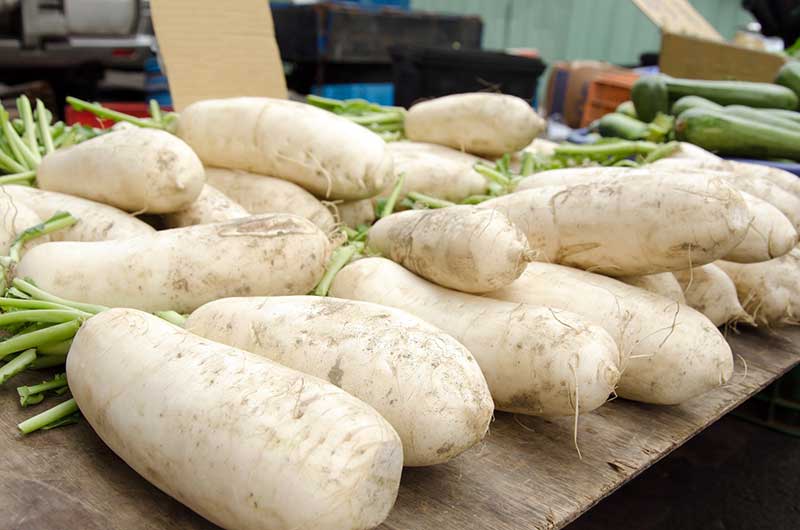
13. Daikon Radish
With its mild taste and crisp texture, daikon radish can be a great addition to a variety of dishes.
Packed with essential nutrients, including vitamin C, potassium, and fiber, this root vegetable promotes healthy digestion and immune system function. Its low calorie content makes it perfect for those watching their weight.
From raw salads to stir-fries and pickling, daikon radish offers endless possibilities. Its subtly sweet flavor adds depth to soups and stews, while its satisfying crunch makes it an excellent choice for fresh spring rolls or homemade coleslaw.
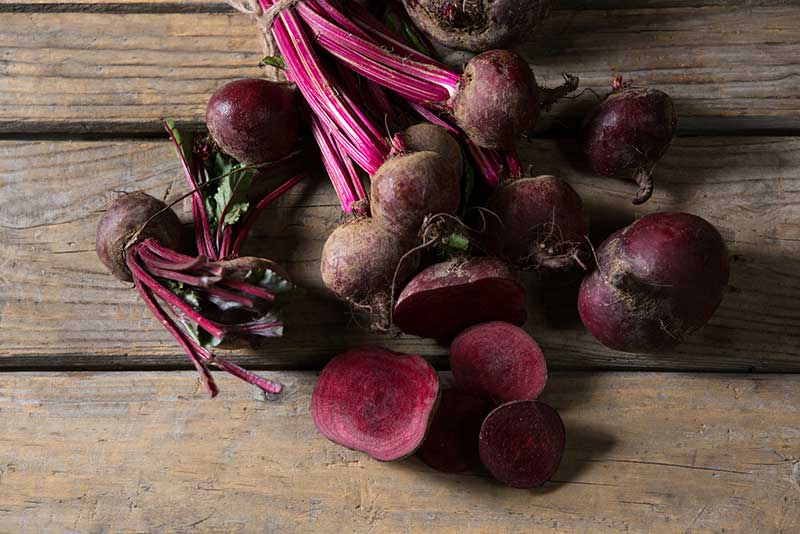
14. Beetroot
Beetroot adds a burst of color and taste to a variety of dishes. Rich in essential vitamins and minerals, beetroot offers numerous health benefits. It is a great source of dietary fiber, folate, manganese, and potassium, which contribute to a healthy digestive system, improved blood circulation, and heart health.
Additionally, beetroot is known for its detoxifying properties and may support liver function. There’s also a ton of health benefits of beetroot leaves, so don’t toss the green tops!
Red beets are also used in a lot of natural coloring for foods and other healthcare products.
15. Mashua
Mashua originates from the Andean region of South America. With a flavor profile reminiscent of a radish or a turnip, mashua offers a unique and slightly peppery taste that sets it apart from more common tubers like potatoes.
While mashua can be boiled, roasted, or even consumed raw, its culinary versatility goes beyond traditional tuber uses. It can be sliced and added to salads for a delightful crunch or used as a colorful garnish for various dishes.
Mashua is low in fat and calories, making it an excellent choice for those aiming to maintain a healthy weight. Additionally, mashua is rich in dietary fiber, providing digestive benefits and promoting a feeling of fullness.
It also contains essential vitamins and minerals such as vitamin C, potassium, and iron.

16. Radish
Classified as tubers, radishes belong to the Brassicaceae family, which includes mustard, kale, and cabbage. In terms of taste, radishes offer a unique combination of crispness and slight peppery flavor.
This delightful crunch adds a refreshing touch to salads, sandwiches, and even as a garnish for various dishes.
When it comes to nutrition, radishes are low in calories and high in fiber, making them an excellent choice for weight management and digestive health. These small root vegetables are also rich in vitamin C, providing you with a natural boost to support a strong immune system. Additionally, radishes offer a good source of potassium.
The uses of radishes extend beyond the kitchen. They can be incorporated into your skincare routine, as their natural antioxidants help to rejuvenate the skin and promote a healthy glow.
There are a lot of health benefits of radish sprouts, so don’t toss the leafy greens on the top!

17. Turnip
A root vegetable with a slightly sweet and peppery flavor, turnips can be roasted, boiled, or mashed, adding a unique taste to dishes. Turnips come in various shapes and sizes, with a crisp and white flesh beneath their purple or white skin.
The taste of turnips is often described as mildly sweet and earthy, with a hint of spiciness.
Turnips are an excellent source of vitamin C, fiber, and potassium. The turnip greens are also very nutritious and can be added to salads or served as a side dish.

18. Rutabaga
Similar to turnips, rutabagas have a sweet and nutty flavor. They are often used in stews, soups, and mashed potato alternatives.
Rutabagas are low in calories and fat, making them an excellent option for weight-conscious individuals. They are a great source of fiber, vitamin C, potassium, and antioxidants, which support a strong immune system and promote overall well-being.
19. Boniato
Boniato, also known as Cuban sweet potato or white sweet potato. They are starchy vegetables with a firm texture and offer a mildly sweet taste reminiscent of regular sweet potatoes.
It can be boiled, steamed, mashed, roasted, or even fried, allowing for a wide range of possibilities.
Whether incorporated into stews, soups, or used as a side dish, boniato adds a delicate sweetness and creamy consistency to any recipe. Additionally, it can be transformed into delectable baked goods, like cakes or pies.
Filled with dietary fiber, boniato aids in digestion and promotes a sense of fullness. This tubercrop is also an excellent source of essential vitamins and minerals, including vitamin C, vitamin A, potassium, and manganese.
Plus, it contains antioxidant properties that contribute to overall health and well-being.

20. Water Chestnut
These small, bulbous vegetables are known for their high water content, making them a refreshing snack option. They are a crunchy tuber used in Asian cooking, especially stir-fries and salads.
Packed with essential nutrients like potassium, manganese, and vitamin B6, water chestnuts offer numerous health benefits, including improved digestion and enhanced immune function.

21. Lotus Root
Lotus root, derived from the lotus flower, is a versatile and nutrient-rich tuber with a mild, slightly sweet taste and unique texture. Whether you incorporate it into soups, stir-fries, desserts, or even as a snack, the lotus seed adds a delightful and satisfying element to your cooking.
Lotus root is renowned for its nutritional profile. Filled with essential vitamins and minerals, including potassium, magnesium, and phosphorus, this tuber promotes overall well-being.
Additionally, lotis root is known for its high fiber content, aiding digestion and promoting a healthy gut.
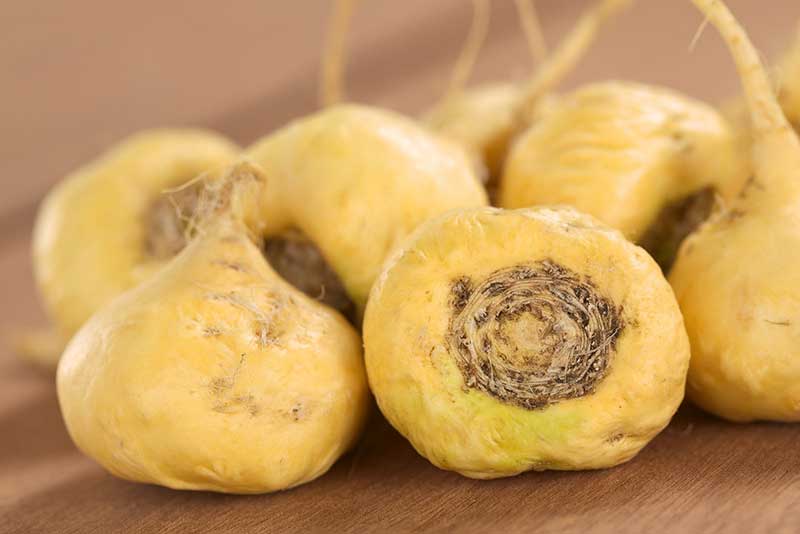
22. Maca Root
Native to the Andes region, maca root is often ground into powder and used as a natural supplement or added to smoothies and mushroom coffee for its potential health benefits.
Maca Root is known to enhance energy levels, boost libido, and improve overall mood. This nutrient-dense tuber is loaded with essential vitamins, minerals, and antioxidants, making it an excellent addition to a healthy diet.
23. Apios Americana
Also known as the American groundnut or Indian potato, apios Americana is a lesser-known tuber with a nutty flavor comparable to a combination of potatoes and roasted chestnuts.
It can be boiled, roasted, mashed, or added to soups and stews. Apios Americana can be used as a potato substitute, bringing a distinct flavor and texture to dishes like fries, gratins, or creamy purees.
Additionally, it can be ground into flour for baking, providing a healthy alternative in gluten-free recipes.
This tuber is a good source of dietary fiber, offering digestive benefits and aiding in weight management. Apios Americana is also rich in protein, containing all essential amino acids required for various bodily functions.
Furthermore, it provides notable amounts of vitamins and minerals, including potassium, iron, manganese, and vitamin C, contributing to overall health and well-being.

24. Celeriac
With a unique flavor resembling a blend of celery and parsley, celeriac is often used in soups, stews, or mashed as a lower-carb alternative to potatoes.
Nutritionally, celeriac is packed with essential vitamins and minerals such as vitamin C, potassium, and phosphorus. Its high fiber content also promotes healthy digestion.
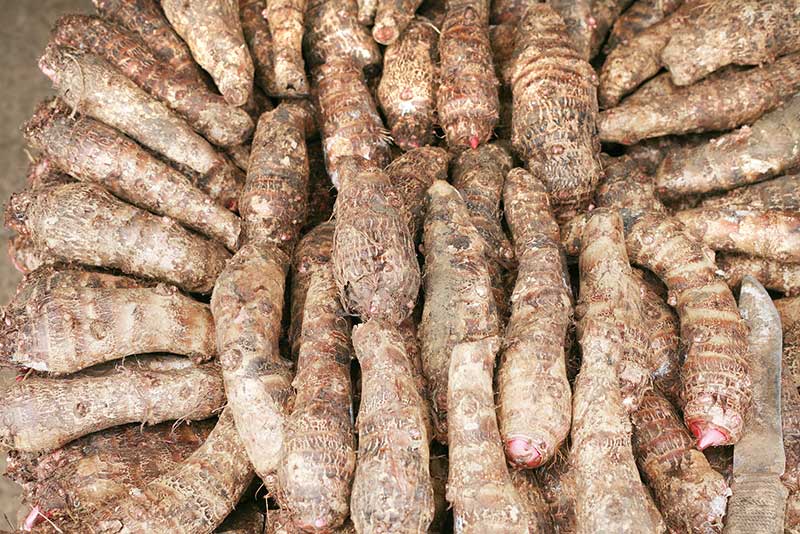
25. Malanga
Popular in Caribbean cuisine, malanga has a starchy texture and mild flavor, commonly used in soups, fritters, or mashed like potatoes.
Malanga is rich in fiber and low in fat. It’s also a fantastic source of energy and aids in digestion. It contains essential minerals like potassium, magnesium, and iron.
Tuber Vegetables
We are only half-way done with our list of tubers. Keep reading to learn about some obscure tubers like the ube, skirret, tannia, oca, and more!

26. Ube
Also known as purple yam, ube is a tuber with a naturally deep purple hue. Widely used in Filipino cuisine, ube has a subtle, sweet taste that is often compared to a combination of vanilla and sweet potato.
This tuber is commonly used in a variety of dishes, such as desserts like cakes, ice cream, and pastries. Its natural hues also make it a popular choice for adding a pop of color to food and beverages.
Beyond its delightful flavor, ube is rich in essential nutrients, including dietary fiber, vitamins, and minerals.

27. Kohlrabi
This vegetable belongs to the cabbage family and has a crisp texture and mild, slightly sweet taste. It can be enjoyed raw or cooked in various dishes. Its flavor is reminiscent of a mild radish or broccoli stem, offering a pleasant, crunchy bite.
Not only does kohlrabi add a delightful crunch to dishes, but it also provides numerous health benefits. Rich with essential nutrients like vitamin C, potassium, and fiber, kohlrabi supports a healthy immune system, aids digestion, and promotes heart health.
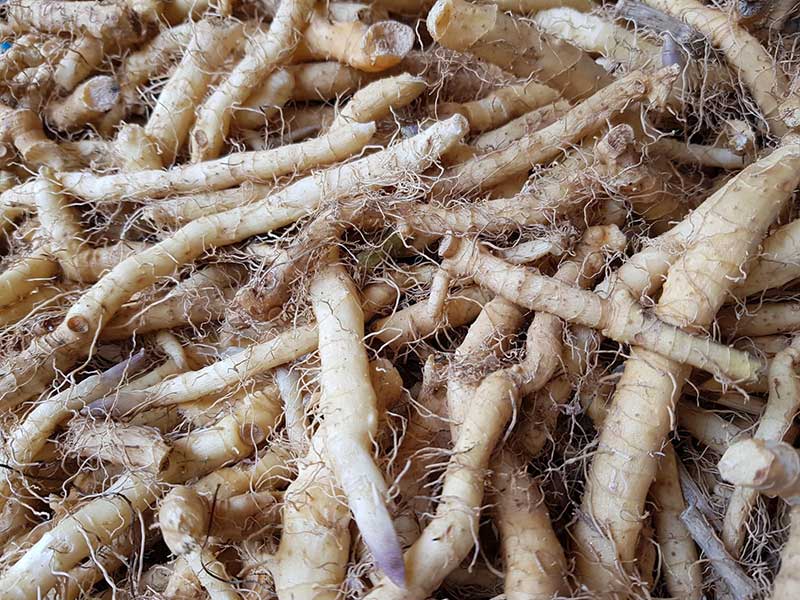
28. Skirret
Skirret, a lesser-known tuber, is sweet and nutty and used in soups, stews, or roasted dishes. It stands out for its impressive nutritional profile, being a good source of dietary fiber, potassium, and vitamin C.

29. Wasabi
Known for its intense spiciness, wasabi is a root vegetable that adds a fiery flavor to sushi, sashimi, and other Japanese dishes.
30. Tannia
Tannia, also known as Xanthosoma, is a versatile tuber with a natural, earthy taste. It offers a unique combination of flavors, often described as nutty and mildly sweet.
Boasting high levels of dietary fiber, tannia aids in digestion and promotes a healthy gut. Additionally, it is an excellent source of potassium, vitamin C, and folate, which support cardiovascular health and boost the immune system.
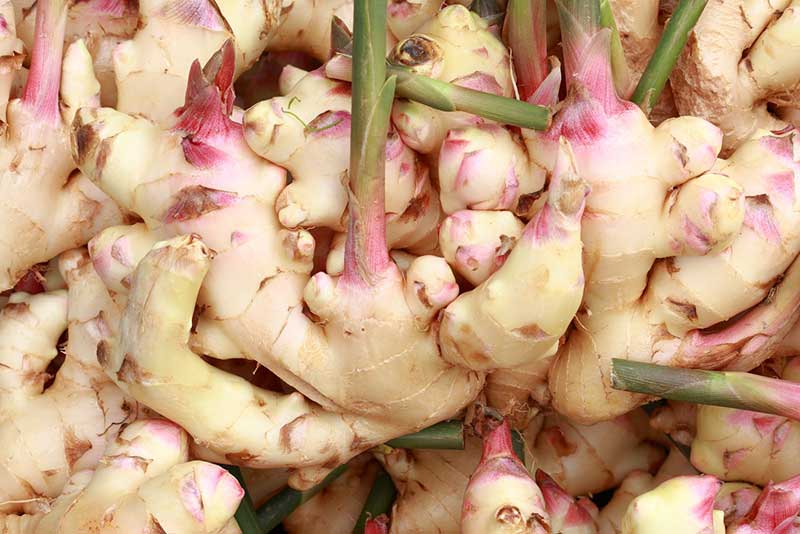
31. Galangal
Galangal is a rhizome similar to ginger, with a citrusy and peppery flavor. It is commonly used in Southeast Asian cuisine, especially in curries and soups.
Beyond its culinary appeal, galangal boasts an impressive nutritional profile. Full of antioxidants, vitamins, and minerals, galangal supports immunity, aids digestion, and reduces inflammation.

32. Shallot
Shallots are small, onion-like bulbs with a milder and sweeter flavor than regular onions. They are often used in sauces, dressings, and French cuisine.
They are a member of the allium family, and not just a flavorful addition to various dishes, but they also offer a range of health benefits.
Shallots are loaded with essential nutrients, including vitamins A, C, and E, as well as minerals like potassium and manganese
33. Crosnes
Crosnes, also known as knotroot, are tubers that belong to the mint family. They sport an unusual appearance, resembling small, knobby white worms.
In terms of flavor, crosnes possess a subtle nutty and earthy taste with a hint of sweetness, making them a delightful addition to various dishes. The texture of crosnes is crunchy and slightly crisp, resembling that of water chestnuts.
These tubers can be enjoyed both raw and cooked, adding a distinct crunch and flavor to salads, stir-fries, and vegetable medleys.
When cooked, crosnes become tender and develop a more delicate flavor profile, making them a versatile ingredient in soups, stews, and side dishes.
Nutritionally, crosnes offer several health benefits. They are low in calories and fat, making them a guilt-free addition to your meals.
Crosnes are also a good source of dietary fiber, which aids digestion and promotes a healthy gut. Additionally, they contain essential minerals such as potassium, manganese, and calcium.

34. Leek
The leek, a member of the Allium family, is a versatile and delicious tuber known for its mild onion-like flavor and crisp texture. Leeks are commonly used in various cuisines worldwide, adding a unique touch to soups, stews, and salads.
Leeks offer a subtler flavor compared to their close relatives, such as onions and garlic. This makes them a perfect choice for individuals who prefer a milder, yet still distinctive, taste in their dishes.
Beyond their delicious flavor, leeks boast an impressive nutritional profile. They are low in calories and fat while being rich in fiber, vitamins, and minerals. This tuber is an excellent source of vitamin K, vitamin A, folate, and manganese.
Moreover, leeks provide antioxidants that support a healthy immune system and contain compounds with potential anti-inflammatory properties.

35. Garlic
Garlic is a flavorful and aromatic bulbous plant that belongs to the Allium family. While commonly mistaken as a root, it is actually a tuber, specifically an underground stem.
In terms of taste, garlic delivers a pungent and strong flavor that ranges from slightly sweet to a distinctively hot and spicy kick. Its unmistakable aroma adds depth and character to a wide array of dishes.
Garlic is renowned for its potential health benefits. It is considered to have antibacterial, antiviral, and antifungal properties. Garlic is also believed to aid in digestion, boost the immune system, and promote cardiovascular health.
Furthermore, it contains essential nutrients like vitamin C, vitamin B6, manganese, and selenium.
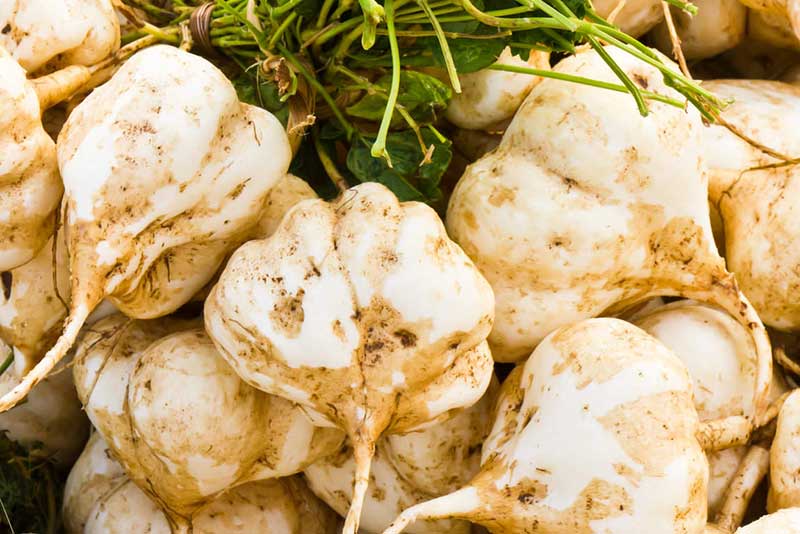
36. Yam Bean
Yam bean, also known as jicama, is a tuberous root vegetable that originates from Mexico and South America. With its crisp and juicy texture, yam beans offers a mildly sweet and refreshing taste.
In terms of its uses, yam bean adds a delightful crunch to salads, slaws, and stir-fries. It can also be used as a healthy alternative to chips when sliced and served as a raw snack.
Yam beans absorb flavors well, making it a fantastic ingredient in salsas, dips, and even as a topping for tacos and sandwiches.
From a nutritional perspective, the yam bean is low in calories and fat, which makes it suitable for weight management. It is a good source of dietary fiber, contributing to digestive health and aiding in appetite control.
Yam bean is rich in vitamin C, essential for immune support, and provides notable amounts of potassium.
37. Scalloped Yam
Scalloped yam, also known as Dioscorea alata, is a unique tuber that boasts a delightful flavor and a plethora of health benefits. With its creamy texture, sweet taste, and orange flesh, scalloped yams are gaining popularity as a versatile ingredient in healthy cuisine.
Scalloped yam offers a naturally sweet and mildly nutty flavor. When cooked, it becomes soft and tender and can be utilized in a variety of culinary creations. It is commonly baked, mashed, or roasted to bring out its natural sweetness.
It is a great source of dietary fiber, aiding digestion and providing a feeling of fullness. These yams are also rich in vitamins A and C, which support immune function and promote healthy skin and vision.
Additionally, scalloped yams contains potassium, manganese, and antioxidants that contribute to overall well-being.
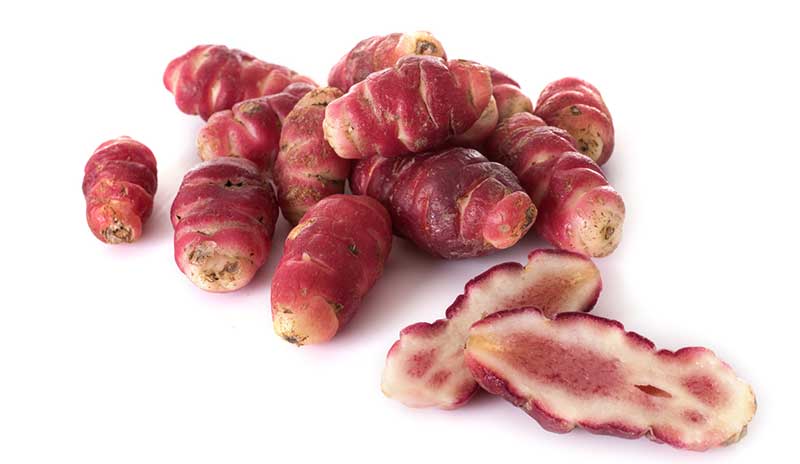
38. Oca
The oca, scientifically known as Oxalis tuberosa, is a lesser-known root vegetable that hails from the Andean region of South America. With a reddish-pink to golden-yellow skin, the oca has a unique appearance that adds a pop of color to any dish.
Oca offers a delicate balance of sweetness and tanginess, similar to a blend of lemon and potato. This makes it a versatile ingredient, suitable for both sweet and savory preparations. It can be boiled, baked, roasted, or even consumed raw.
Low in calories and fat, oca is an ideal choice for those watching their weight. It is also rich in dietary fiber, which aids in digestion and promotes satiety.
Oca contains essential vitamins, including vitamin C, which supports a healthy immune system, and B vitamins, which help with energy production. Moreover, it is a great source of minerals like potassium, iron, and calcium.

39. Water Spinach
Also known as kangkong or morning glory, and Chinese watercress water spinach is a leafy green vegetable with tender stems and a refreshing and slightly earthy flavor, akin to spinach or kale.
It offers a delicate crunch, especially when served raw or lightly cooked, lending a pleasant texture to meals. Water spinach is incredibly versatile and can be incorporated into a wide range of dishes. It pairs well with stir-fries, soups, salads, and even smoothies.
Its tender leaves and young stems are commonly used in cooking, while the mature stems can be used to make pickles or added to stews. Some regions also utilize the tubers as a crunchy addition to salads or as a thickener in soups.
Water spinach is low in calories but rich in vitamins A, C, and K, as well as minerals like calcium, iron, and potassium. It also contains dietary fiber, which aids digestion and helps maintain a healthy gut.
Additionally, water spinach is a good source of antioxidants, which play a crucial role in neutralizing harmful free radicals in the body.
40. Breadroot
Breadroot, also known as Indian breadroot or Psoralea esculenta, is a tuberous root vegetable that belongs to the legume family. It is primarily found in the Great Plains region of North America.
This unique tuber vegetable has a mild and nutty flavor, similar to that of a potato or a chestnut, with a firm yet tender texture. It can be boiled, roasted, mashed, or even ground into flour.
Breadroot can be used as a substitute for potatoes in soups, stews, and casseroles. It can also be sliced and fried to make crispy chips or grated and added to baked goods for added texture and flavor.
Breadroot has been traditionally used by Native American tribes as a staple food source due to its abundant nutritional benefits. It is an excellent source of carbohydrates, providing sustained energy.
It also contains significant amounts of protein, dietary fiber, and essential minerals such as potassium, iron, and calcium.
41. Chinese Artichoke
Chinese Artichoke, also known as Stachys affinis or Crosnes, is a nutritious tuber that boasts a crisp texture and a slightly sweet, nutty flavor. It can be enjoyed both raw and cooked.
When eaten raw, it adds a crunchy element to salads and vegetable platters. It can also be pickled to enhance its tangy taste. When cooked, Chinese Artichoke can be sautéed, roasted, or stir-fried, adding a delightful crispness to various dishes.
Chinese Artichoke is an excellent source of dietary fiber, which supports healthy digestion and helps maintain a feeling of fullness. It is also low in calories, making it a great addition to weight management and calorie-conscious diets.
It also contains vitamins and minerals, including vitamin C, potassium, and iron.
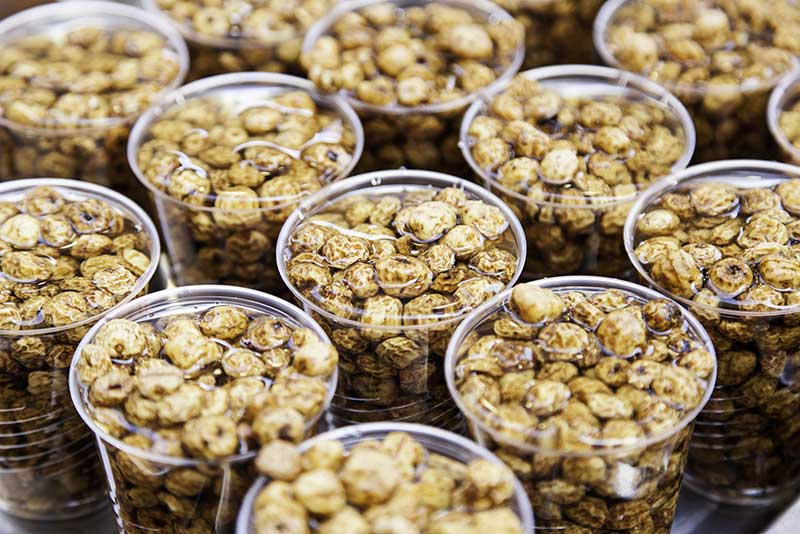
42. Tiger Nut
Despite its name, tiger nut is not a nut but a small tuber with a sweet and slightly nutty flavor. It is often used to make horchata or added to baked goods. It has a distinctive, sweet and nutty flavor profile.
They can be consumed as a standalone snack, added to trail mixes, sprinkled over salads, or blended into smoothies for an extra boost of natural sweetness. Tiger nut milk, a dairy-free plant-based beverage, has also gained popularity due to its creamy texture and appealing taste.
Tiger nuts offer an impressive array of health benefits. These little wonders are a great source of dietary fiber, which aids in digestion, promotes feelings of fullness, and supports a healthy gut.
They are rich in vitamins E and C, providing an antioxidant boost for overall well-being. Not only that, but tiger nuts are an excellent source of minerals such as iron, magnesium, and potassium.

43. Yuca
Yuca is a starchy tuber that is widely consumed in many cultures around the world. It is native to South America but is now grown and enjoyed globally.
Yuca has a mild and slightly sweet taste, reminiscent of a potato but with a smoother texture. When cooked, it develops a creamy and tender consistency
Yuca is a significant source of carbohydrates, providing energy for the body. It also contains dietary fiber that aids digestion and promotes a healthy gut. Yuca is a good source of vitamin C, which supports the immune system, and vitamin B complex, essential for energy production.
It also contains potassium, magnesium, and calcium, and antioxidants, such as beta-carotene, which can help protect against cellular damage.
44. Konjac
Also known as devil’s tongue, konjac is a gelatinous tuber used in Asian cuisine. This ancient Asian plant has a multitude of uses and offers a range of nutritious benefits.
Konjac itself doesn’t possess a distinct flavor. Its neutral taste allows it to absorb the flavors of other ingredients, enhancing the overall dish without overpowering it.
One of the most popular uses of konjac is in the form of konjac noodles, also known as shirataki noodles. These translucent, gelatinous noodles are gluten-free, low in calories, and high in fiber.
Konjac is also used to make konjac flour or powder, which can be utilized as a thickening agent in sauces and gravies.
It is exceptionally low in calories and carbohydrates, while being high in dietary fiber. This combination makes it suitable for those following a low-calorie or low-carbohydrate diet, or individuals aiming to increase their fiber intake.
Furthermore, konjac is rich in glucomannan, a soluble fiber known for its ability to promote feelings of fullness and aid in weight management. It also helps regulate blood sugar levels and supports digestive health.
45. Chinese Yam
Chinese Yam is a tuberous root vegetable native to East Asia. It boasts a mildly sweet and earthy taste, making it an excellent addition to both savory and sweet dishes. Its texture is smooth and starchy, similar to a potato, but with a slightly crisp bite when cooked.
It can be boiled, steamed, mashed, or added to stir-fries, soups, and stews. Additionally, it can be used as a substitute for potatoes or sweet potatoes in various recipes. Chinese Yam can even be thinly sliced and enjoyed raw in salads or as a crunchy, nutritious snack.
Chinese Yam is full of essential nutrients, making it a valuable addition to a healthy diet. It is an excellent source of dietary fiber, aiding digestion and promoting satiety. Chinese Yam is also rich in vitamins C and B6, providing immune support and contributing to brain health.
Additionally, it contains potassium, manganese, and antioxidants that help support cardiovascular health and fight oxidative stress.
46. Chinese Red Meat Radishes
Chinese red meat radish, also known as the watermelon radish, is a unique tuber that’s visually striking, with its green and white exterior giving way to a beautiful pink or red interior.
It has a pleasantly mild and slightly peppery taste, reminiscent of regular radishes. However, what sets it apart is its subtle sweetness. When cooked, the radish tenderizes and develops a milder flavor.
It can be sliced and eaten raw, adding a pop of color and flavor to salads, slaws, and vegetable platters. Its unique appearance makes it an excellent garnish for any dish. When cooked, it can be roasted, stir-fried, or steamed, adding a mild and sweet flavor to stir-fries, soups, stews, and even pickling recipes.
Chinese red meat radish is an excellent source of vitamin C, providing a boost to the immune system and supporting overall health. Additionally, it contains essential minerals, including potassium, calcium, and iron.
With its high water content and low-calorie count, it makes for a great addition to any weight-conscious individual’s diet. Moreover, its fiber content aids digestion and promotes a healthy gut.

47. Elephant Foot Yam
Elephant Foot Yam is a versatile tuber with a plethora of health benefits. It has a a mildly sweet and nutty flavor and can be boiled, roasted, steamed, or fried to create dishes such as curries, soups, stir-fries, or even nutritious chips.
Loaded with essential nutrients, the Elephant Foot Yam offers an array of health benefits. It is a great source of dietary fiber, aiding in digestion and promoting a healthy gut.
It is rich in vitamins B6 and C, providing a natural boost to your immune system. Elephant Foot Yam also contains essential minerals like potassium, iron, and copper.
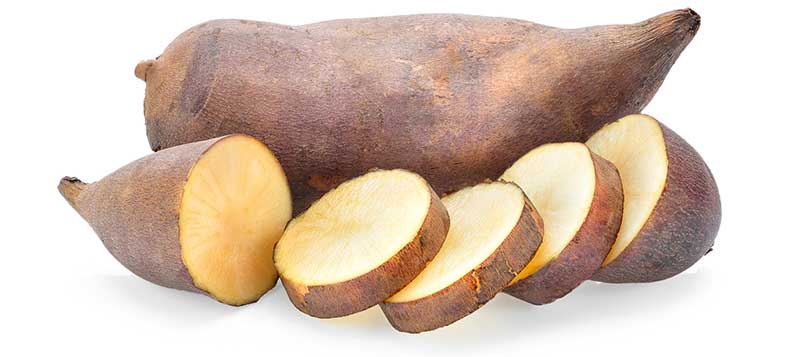
48. Yacon
Yacon is a versatile root vegetable, native to the Andes region. It offers a delightful taste, an array of uses, and an impressive nutritional profile. It has a subtly sweet and juicy flavor with hints of apple and pear. Its crisp texture resembles that of water chestnuts.
It can be consumed raw, adding a pleasant crunch to salads or slaws. Yacon syrup, extracted from its tuber, serves as an excellent natural sweetener.
This tuber is low in calories and high in dietary fiber, it aids in digestion and supports weight management. Yacon is also rich in prebiotic fructooligosaccharides (FOS), promoting a healthy gut microbiome.
Additionally, it provides essential minerals such as potassium and calcium, along with vitamins A and C, contributing to overall immune system support.
You can use yacon syrup as a sweetener, and it even works when making substitutes for simple syrup!
49. Chinese Potato
Resembling small potatoes, Chinese potatoes have a firm and waxy texture. Chinese potatoes offer a delightful blend of sweet and nutty flavors. Its mild taste allows for integration into various dishes, making it a versatile ingredient. They are commonly used in stir-fries, curries, or pickled.
Rich in dietary fiber, it aids in digestion and promotes a healthy gut.
The Chinese potato is a great source of essential vitamins and minerals, including vitamin C, potassium, and manganese. These nutrients contribute to overall well-being, supporting immune function, bone health, and normal metabolism.
50. Chinese Artichoke
Chinese artichoke, also known as crosne, is a lesser-known tuber with a knobby appearance and nutty flavor. Its texture is crunchy, akin to water chestnuts or jicama.
This tuber can be enjoyed both raw and cooked and is often incorporated in salads, stir-fries, soups, and even pickled for added tanginess.
Its appealing texture and subtle taste make it a great addition to vegetable medleys, gratins, and roasted dishes. Chinese artichoke is also often utilized as a garnish due to its visually striking appearance.
Nutritionally, Chinese artichoke is an excellent source of dietary fiber, essential for maintaining a healthy digestive system. It is low in calories and fat and contains important minerals such as potassium, calcium, and iron, which contribute to overall well-being.
Where to Buy Tuber Vegetables
Most grocery stores will carry common tubers, such as potaotes, sweet potatoes, garlic, shallots, etc. But what about some of the lesser-know tubers like oca, konjac, malanga, and yacon?
Here are some places you can find other types of tuber vegetables:
1. Farmers’ Markets: Local farmers’ markets are excellent places to find obscure tuber vegetables. These markets often feature a diverse range of produce, including lesser-known tubers.
2. Specialty Grocery Stores: Specialty grocery stores that focus on organic or international products are great places to find obscure tuber vegetables. These stores often carry a wider selection of produce, including lesser-known varieties.
3. Ethnic Grocery Stores: Exploring ethnic grocery stores is a fantastic way to discover new tuber vegetables. Different cultures have their own unique varieties of tubers that might not be commonly found in mainstream grocery stores.
How to Properly Store Tubers
Proper storage of tubers is crucial to maintain their freshness, flavor, and nutritional value.
- Choose the Right Environment: Tubers, such as potatoes, sweet potatoes, and yams, require a cool, dark, and well-ventilated environment for optimal storage. Avoid storing tubers near sources of heat, direct sunlight, or in areas with high humidity.
- Clean and Dry: Before storing tubers, make sure to brush off any excess soil or debris gently. Washing tubers is not recommended as moisture can lead to rot.
- Individual Wrapping: For extended storage, wrap each tuber individually in newspaper or paper towels. This will help prevent moisture buildup and keep them from touching each other, reducing the risk of mold growth or sprouting.
- Storage Containers: Use breathable storage containers, such as mesh bags or baskets, to allow air circulation. Avoid using plastic bags or airtight containers, as they can trap moisture and promote decay.
- Temperature and Humidity: The ideal temperature for tuber storage ranges between 45°F and 55°F (7°C and 13°C). Additionally, maintaining a humidity level of around 85% can help prevent tubers from shriveling. Consider using a root cellar, a cool basement, or a refrigerator’s vegetable drawer to achieve the desired conditions.
- Separate from Other Produce: Tubers release a natural gas called ethylene, which can accelerate the ripening and decay of other fruits and vegetables. It’s crucial to store tubers separately from ethylene-sensitive produce like bananas, apples, and greens to avoid premature spoilage.
- Regular Inspection: Check your stored tubers regularly for any signs of decay or sprouting. Remove any damaged or spoiled tubers immediately to prevent the spread of rot to others.
- Utilize FIFO Method: When you have multiple tubers in storage, practice the First In, First Out (FIFO) method. This means consuming the oldest tubers first to prevent wastage and maintain freshness.
Freezing Tuber Vegetables
Wondering about fresh vs frozen vegetables? Potatoes, sweet potatoes, and yams are tuber vegetables that freeze well.
Tuber Vegetables as a Staple Food
Tuber vegetables have played a vital role in human diets for centuries, serving as a reliable source of sustenance. Potatoes, in particular, have been a staple food for various cultures worldwide.
Their versatility in cooking methods (from mashed to French fries) has made them a favorite among both home cooks and professional chefs. Other tuber vegetables, such as yams and sweet potatoes, have also become popular due to their distinct flavors and nutritional benefits.
Tuber vegetables are sometimes roasted with other root vegetables and certain types of squash, like butternut and acorn.
Final Summary
Tubers are fascinating plant structures characterized by their fleshy roots that store energy and nutrients. These large tubers serve as a vital source of sustenance for many plant species, enabling them to survive in various environments.
Tubers play a crucial role in plant propagation and serve as a reservoir for new growth. By storing essential nutrients and energy, tubers help plants withstand unfavorable conditions such as drought or harsh winters. Their ability to sprout new shoots and roots ensures the survival and proliferation of the plant. Understanding the significance of tubers in plant biology sheds light on their importance in agriculture and horticulture practices.
Understanding the unique characteristics and growth processes of tuber crops allows us to appreciate their importance in the world of healthy, plant-based eating.

